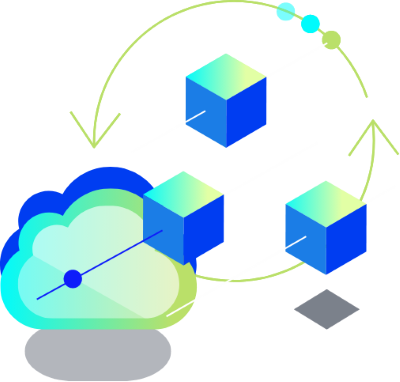What is Cloud Native ?
Cloud native lets business construct, deploy and maintain applications in the cloud within a flexible architecture. Crucially, these apps allow enterprise to leverage the many advantages offered by cloud-based services including the flexibility, scalability and resilience needed to remain competitive in tough market conditions.

What does cloud native mean?
Going cloud native is vital to modern organisations that want to introduce new functionality or services that take full advantage of the cloud’s elasticity and distributive potential to meet enterprise and client demands.
‘Old school’ solution
Cloud native development is now vital as traditional methods of software development can no longer cut it in our fast-moving world. For instance, software development has typically been based on the monolithic model; a single custom-designed and built ‘structure’ where each element – for instance, scripts and processes – are often dependent on one another.
This means evolving, changing or updating a monolithic solution’s code requires time and caution. Think of a Jenga tower – or tumbling tower blocks – where removing one piece to replace it with another represents a potential risk to the entire infrastructure. Remove too many and that tower will eventually tumble down, crippling the system.
In real world terms, evolving monolithic software is now becoming too complex, challenging and costly – and no longer practical within a modern, fast-moving organisation where any downtime can impact bottom lines and cause reputational damage.
Cloud native vs monolithic
Enter cloud native, which takes the opposite approach to monolithic. Creating cloud-native apps sees each application divided into individual software services, called microservices. A microservice fulfils a particular function within the app – think payment, search, display, etc.
Importantly, each can be managed individually and independently, meaning you don’t need to worry about negatively impacting on the underlying infrastructure. All in, cloud native technologies make it easier to provision scaled cloud native apps to several million users simultaneously, no matter where they are in the world.
How are cloud native technologies delivered?
Running behind the scenes, cloud-native application development services and cloud native platform give you the tools, model and infrastructure you need to develop, roll out and maintain cloud native apps. Example include:
Microservices
These form the beating heart of any cloud-native architecture with each microservice independently tackling a specific business function (payment, search, display, etc.). Developed autonomously, microservices offering different services are combined to create an app, connected to one another using an application programming interface. Crucially, developers can change a microservice within an application without needing to take the entire app offline. This means new functionality or maintenance/upgrade work can be carried out without disruption to the enterprise.
DevOps
Crucial to going cloud-native, this approach sees developers and IT operation teams working together, breaking down internal silos to create a single entity committed to improving application modernization outcomes. Successful DevOps achieve this by automating software creation and delivery processes as well as infrastructures, relying on each other as well as crucial cloud native technologies processes and resources such as continuous integration/continuous delivery.
Container registry
Container images are stored and managed within a container registry, which provides all vital details on the ‘contents’ of the container from versioning and access control through to metadata/tagging and the software components themselves. This registry is then used by the container orchestration platform to access the container. Popular container registry solutions include Docker Hub, Google Container Registry, Amazon Elastic Container Registry and Azure Container Registry.
Continuous integration/continuous delivery (CI/CD)
Continuous integration (CI) allows coders to make changes to existing code without worrying about testing as the CI runs automated testing processes. CI checks for bugs as well as ensuring any new code is compatible with existing coding. This gives devs far quicker feedback and reduces risks to the codebase. Continuous delivery also automates the deployment of new code into the existing codebase. Combined, these cloud native technologies enable changes to be made to cloud native apps at speed and at scale, delivering shortened release cycles and consistent, reliable results.
Serverless computing
This allows dev teams to move away from managing the logistics of environments and infrastructure such as provisioning or managing servers. Instead, they can focus on building and coding exclusively, allowing the cloud-native approach to take on the behind the scenes ‘busywork’ such as automating resources scaling. Such functionality offers a range of benefits. It makes work easier and, for the business, creates a more cost effective coding process as development is simplified, the use of resources massively optimised, and performance enhanced.
Notifications
Delivered via comms channels of your choice, notifications are generated in real time and sent to alert enterprise stakeholders about potential issues such as a failed deployment. They can also be leveraged to provide vital updates about account activity or any instances of high resource usage. Ultimately, notifications enable enterprise to monitor all cloud native apps, environments and infrastructure at a glance.
Container orchestration platforms
A cloud native platform enables you to automate the scaling and management of applications that are containerised – known as container images. Container images are made up of the executable software components, libraries, dependencies and more. These are used to create a cloud-native application, enabling you to pick up, move and run your code in any environment. Cloud native technologies represent the ultimate in portability – and are one of the core strengths of going native cloud.
To orchestrate such potentially complex operations, leading container orchestration platforms like Kubernetes are used to massively simplify the process so you can focus solely on exploiting the container’s components, no matter the environment. To achieve this, the platform gives your teams complete control over the containers, ensuring you know where and how they are executed at all times.
What is the difference between cloud and native cloud?
Both are crucial to creating modern systems and applications. However, ‘cloud’ refers to cloud computing. The business pays a rolling fee to gain access to an on-demand service including a remote data server, which gives you access to the computing resources needed to go cloud native.
Such cloud native technologies combined with a cloud native platform enable you to build and deliver applications before deploying them in the cloud – or if preferred, transfer any cloud native apps into a hybrid cloud or on-premise only. To enjoy the best that cloud native has to offer, both cloud and cloud native are essential for businesses that want to put themselves in the best position to meet all their future computing needs.
What are the benefits of cloud native for business?
The cloud-native approach has rapidly become the gold standard for developing modern applications and environments, delivering a range of significant benefits. Examples include:
Develop without fear
Cloud-native microservices can be added or updated independently and deployed without affecting the stability or availability of the cloud native app itself. This enables you to make improvements by iterating whenever required – without ever posing a threat to your operations.
Secure business continuity
Business continuity is strengthened by a microservice-first architecture. For companies adopting a hybrid and multi-cloud strategy, the risk of prolonged downtime is also low, meaning back office as well as customer experiences remain far more protected.
Reduce time to market
As your needs evolve, your applications must be able to adapt to meet them. Going cloud native speeds up cloud native application development. Deploy upgrades without time-consuming steps – such as configuration, standardisation, tests, additions, modifications, etc. – as these are now fully automated, reducing the time between design and production or the need for deep management.
Be truly independent
Any cloud-native approach is based on an ecosystem of open source, interoperable services that promote code portability from one service provider to another – so long as your approach remains compliant with open source standards. This also removes the dangers of vendor lock-in, enabling you to maintain complete sovereignty over your infrastructure, cloud native apps and services.
Leverage budgets better
Thanks to the time saved by cloud native, the costs of managing a traditional infrastructure can be allocated to other developments instead. Crucially, you no longer need to risk wasting provision resources as computing, network and storage resources are allocated dynamically to meet your real infrastructure needs.
Boost security levels
The more attack surfaces you have, the more open to threat you are. Cloud-native applications boost security by minimising your attack surfaces while improving your ability to identify and address threats or vulnerabilities. Also, patching and updating is made more simple thanks to cloud-native’s standardised deployment and management.
Increase resilience and availability
Cloud-native design offers inherent infrastructure resilience and increased application availability, as well as the automation of environment deployments and their associated configurations. This makes it easier to establish update, production implementation and redundancy scenarios, and even develop a robust disaster recovery and data backup plan.
Remain compliant 24/7
Because security controls for cloud native applications are administered at the platform level, the need – and expense – of meeting data compliance regulations is greatly reduced. Any reputable cloud provider will also have strict security processes in place to ensure risk management strategies meet all regulatory requirements.
OVHcloud and Cloud Native
We offer a range of PaaS solutions to aid you go cloud native, allowing you to automatically orchestrate your containerised applications, accelerate your time-to-market and get access to a scalable infrastructure that allows any enterprise to outperform its competitors.

Orchestrate your containers
Kubernetes is one of the most widely-used container orchestration tools on the market, adopted by companies of all sizes. It can be utilised to deploy applications, scale them up and make them more resilient — even within hybrid or multi-cloud infrastructures.

Accelerate your time-to-market
With our cloud native platform as a Service solution, you can automatically orchestrate your containerised applications, integrate your software factory deployments, and adopt Infrastructure as Code. Combined, they enable you to deploy a winning cloud-native strategy to help future proof your operations in an increasingly competitive market.

Scale your cloud-native application
Get an automated and scalable cloud-native architecture by discovering the power of automation on a full three-node Kubernetes cluster that leaves you free to focus on the software layers. To help you get started, use robust discovery instances for your first steps with Kubernetes and introduce more powerful instances at any time.